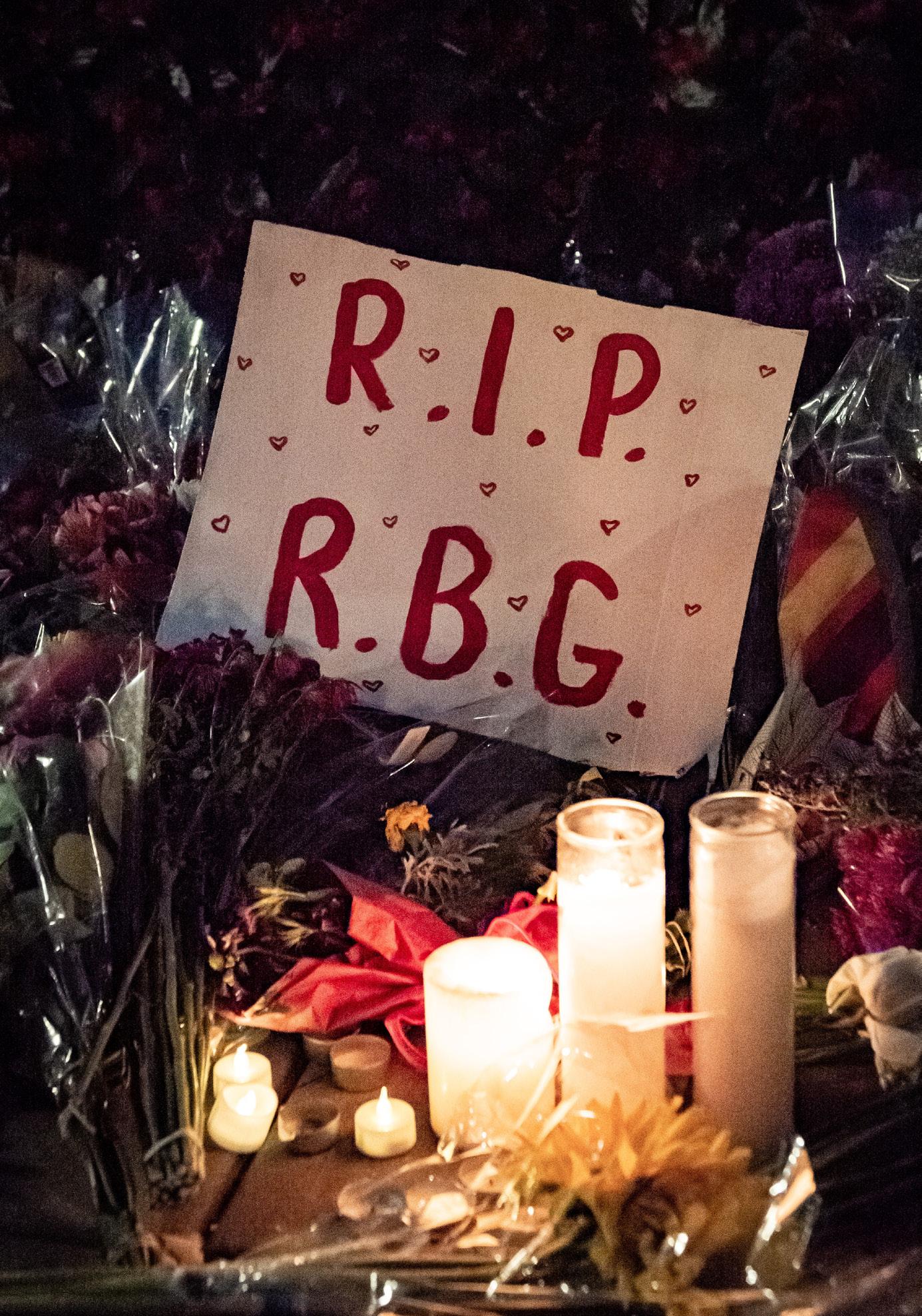
15 minute read
BlackatMSUTexas
DALLAS WABBINGTON REPORTER
Black students share stories of racism through Twitter hashtag.
Following the country’s response to the Black Lives Matter protests in June 2020, the leaders of the Black Student Coalition, including Jamilah Kangudja, educational leadership graduate and Black Student Union president, gathered in June to discuss how to help the Black community and bring awareness to racism on campus. Together, the organization created the hashtag #BlackatMSUTexas to encourage Black students to come forward and tell about their experiences with racism. After BSU members released the initial statement explaining the purpose of the hashtag, many people, including students, faculty and organizations gathered on Twitter in solidarity to inform the community that racism exists on
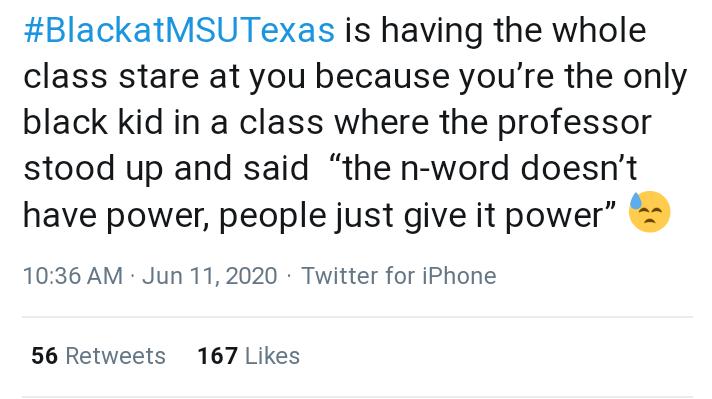
the MSU Texas campus.
“[Racism] is something that has been happening at MSU. The stories are real,” Kangudja said. “If you look at the stories that people are telling with this hashtag, you’ll see a lot of them overlap, meaning year after year, semester after semester students are experiencing the same things.”
The hashtag received immediate attention, with more than 100 tweets made up of experiences and reactions since its creation. The hashtag continues to be used by students three months later and continues as a place of admission for Black students.
As one of the few minority students in a previous class of hers, mass communication junior Keza Muvunyi said she was afraid to have discussions of racial injustice and white privilege because she wasn’t sure if she was the only one who shared her perspective, so she tweeted this experience with #BlackatMSUTexas.
“We had a guest come speak to our class and there was one student who finally did speak up about it to say white privilege didn’t exist. [The guest] said something along the lines of ‘People just use it as an excuse to act a certain way.’ The one time someone tries to speak up, it was complete, utter nonsense,” Muvunyi said. “It was frustrating, and it was frustrating to me because if I did have something to say, I would be the only one to back myself.”
Muvunyi told a story about how in her group of friends she was the only Black person, and her non-Black friend was trying to describe a Black woman, stating descriptions aside from her race.
“It’s okay to say she was Black. It wasn’t a negative term or anything, but she was hesitant to say it just because I was in their presence,” Muvunyi said. “That has happened a lot, and that’s something people brush off, because it’s not a micro-aggression brushed off as much
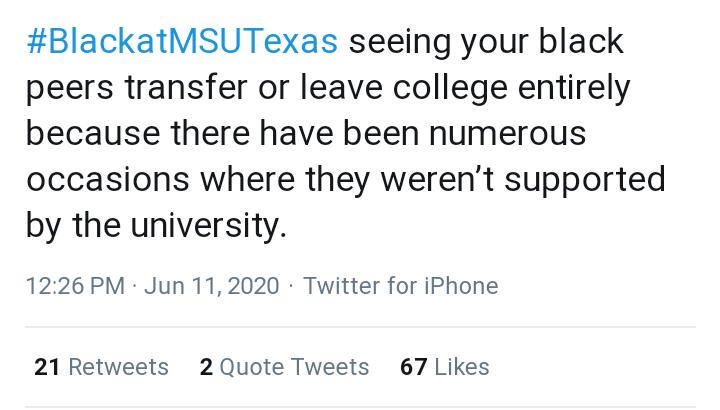
as others. My presence made someone else uncomfortable. When they made their discomfort known, it made me uncomfortable.”
Muvunyi explained that this is how people in general tend to function around minorities. She continued and said people are comfortable saying these terms when those individuals are not in their company.
“They avoid those words when they are in the presence of that person, and I think that is problematic because you are afraid of calling me who I am even in the terms that are considered okay,” Muvunyi said.
Business management alumni Leroy Flex was one of the more frequent participants of the hashtag; one of his stories revealed the common problem of Black individuals being asked by non-Black people for their permission to say the N-word. Flex tied this question to a deeper problem: if there is not police or authority involved, people will say what they want.
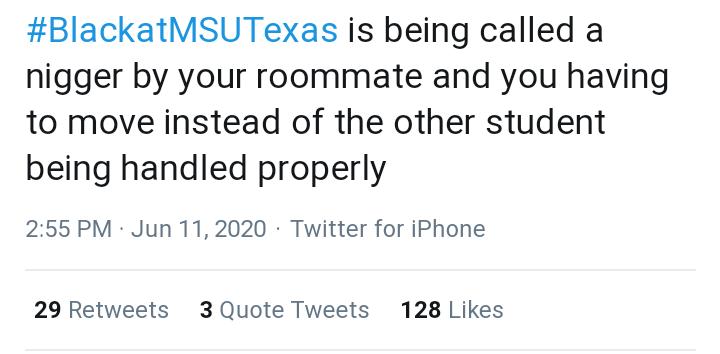

#BlackatMSUTexas
Regarding how many times people ask if they can say the N-word, Flex said,“It’s been every other week, since I’ve been at MSU. It’s been off campus too. It’s not even on campus every time, the town is like that too. Even at work, people will ask that question. Especially on campus, it’s every other week.”
Flex said even his friends would make racist remarks around him, telling him it’s better than them hiding what they say.
“Imagine if your two main friends on campus are two white guys, and they’re the most racist ones. If you were to talk to them and hear how they talk about [Black people], it’s just like having the drunk uncle that you know is always drunk. You let him be drunk and don’t bother him. That is usually the approach I take. They are them, and I know they are like that,” Flex said.
Students have also expressed their opinions about the lack of action taking place by the university to address reports of racism. Muvunyi discussed a tweet about an event where a student was being harassed by her own roommate because she was Black.
“About a year and a half ago there was a girl who had an issue with her roommate who wrote ‘Go back to the cotton fields’ or something like that. That whole story broke my heart. Hearing her perspective on it and how she didn’t get any type of justice besides getting a new room broke my heart,” Muvunyi said.
This hashtag provided Black students with a virtual environment where they could share their stories, and other students could learn about the acts of racism among their peers.
“[This experience] changed how I viewed MSU students, because I saw other Black students suffer worse discriminatory actions. It made me feel closer to the Black community in a way where we shared a lot of the same experiences, or just by getting to know what other
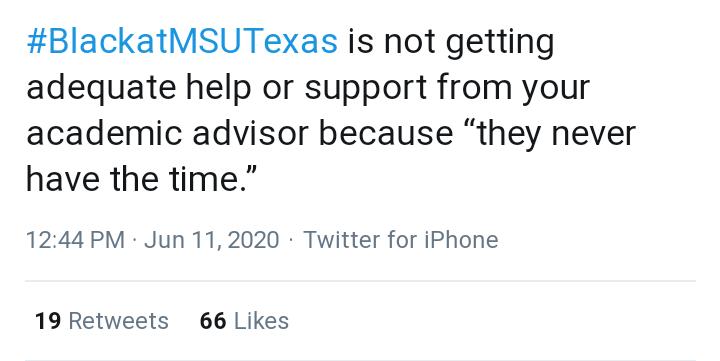
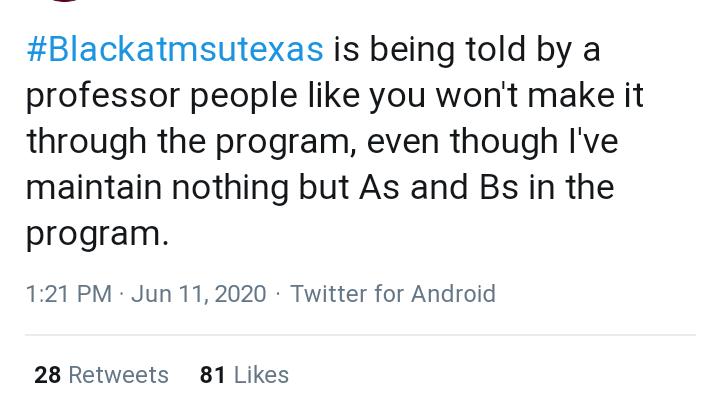
Black students were going through,” Muvunyi said. “It made me feel closer just knowing how others struggled. That’s why I love the hashtag.”
Muvunyi continues to bring awareness to racism on campus by asking and encouraging non-Black students to go through the hashtag and read about what students have experienced.
“Most of the people I talked to had never heard of what it was. I remember one conversation, I was talking to a girl and she was completely shocked. She told me she would go back and read through [the tweets],” Muvunyi said. “I feel like that’s a way that I’m making this hashtag extend from just a summer thing to something that is actually happening daily, just by asking students ‘How do you feel about this as a Black student, minority student or a white student who hasn’t heard of it? Read these tweets and tell me how you feel.’”
Kangudja admitted how this is a scary time for Black lives but said if the community does not speak on these issues, then they will continue to happen. She also said there are ways people can support the Black community and offered advice to those afraid to speak out.
“It’s not to make anyone feel like it’s their duty or their calling to do so or speak up, because you can do other things outside of just speaking up or whatever the case may be. You can donate. You can do things like register to vote, and when you register to vote, make sure you read up on all of the potential candidates, doing little things like that,”Kangudja said. “Incorporating ways and practicing and learning how to be anti-racist. A lot of people wouldn’t consider themselves a racist, but a lot of people can’t necessarily say they’re anti-racist. My advice would be true to yourself. Be true to yourself and believe in yourself.”
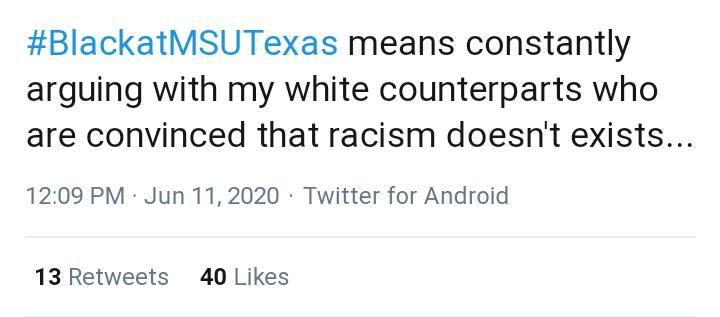
NOTORIOUS RBG: The Legacy of Ruth Bader Ginsburg
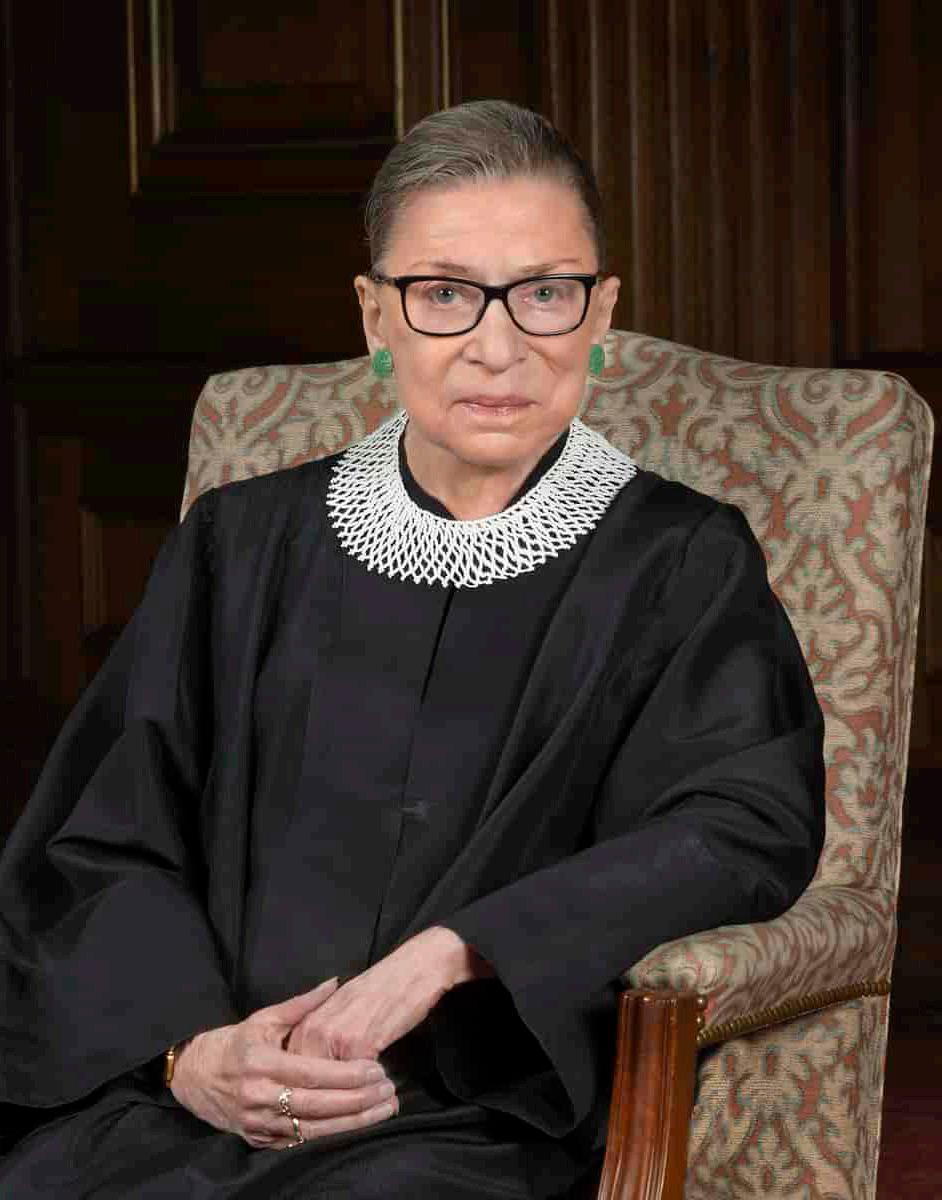
EMILY BEAMAN REPORTER
On Sept. 18, 2020, Supreme Court Justice Ruth Bader Ginsburg passed away due to complications with pancreatic cancer at the age of 87.
Ginsburg was interred next to her husband at the Arlington National Cemetery and is the first woman and first Jewish person to lie in state at the United States Capitol.
Her achievements have not gone unsung. The other eight members of the Supreme Court released their statements on her passing on Sept. 20. Supreme Court Justice Sonia Sotomayor pays admiration to Ginsburg’s accomplishments.
“[She] was an American hero,” Sotomayor said. “She spent her life fighting for the equality of all people, and she was a pathbreaking champion of women’s rights. She served our Court and country with consummate dedication, tirelessness, and passion for justice. She has left a legacy few could rival.”
Ginsburg’s feats began before she was appointed to the Supreme Court. Fellow Supreme Court Justice David H. Souter recognizes this in his statement.
“Ruth Ginsburg was one of the members of the Court who achieved greatness before she became a great justice,” Souter said. “I loved her to pieces.”
The nickname Notorious RBG came from a Tumblr post made by NYU Law Student Shana Knizhnik in 2013. She explained that it was the juxtaposition of Ginsburg’s small stature and powerful presence that inspired her to create the nickname influenced by Notorious B.I.G.
Ruth Bader Ginsburg was influential in the fight for women’s equality. Furthermore, her shadow remains in American everyday life because of her work from the past.
Ginsburg was born in Brooklyn, New York on March 15, 1933. She then attended Cornell University, where she graduated as the highest-ranking female student from her class on June 23, 1954. During her time at Cornell, she met Martin D. Ginsburg, who she married a month after graduating. They had a daughter, Jane, in 1955 and a son, James, in 1965. Shortly after the birth of their daughter, Ginsburg’s husband was diagnosed with testicular cancer. In 2010, he died from complications of metastatic cancer.
While working at the Social Security Administration in Lawton, Oklahoma, she was demoted after her workplace was notified she was pregnant.
While enrolled at Harvard Law, the dean invited all nine of the school’s female students to dinner, where he reportedly asked them, “Why are you here, taking the place of a man?” Both Ginsburg and her husband were students at Harvard, and while he was receiving treatment for his first diagnosis of cancer, Ginsburg attend ed class, made notes and dictated papers for both of them. She made the Harvard Law Review.
After transferring to and graduating from Columbia Law, where she became the first woman in two major law reviews and tied for first in her class ranking, she applied as a law clerk with Supreme Court Justice Felix Frankfurter but was rejected because she was a woman and a mother.
In 1963, Ginsburg became a professor at Rutgers Law School and was one of the twenty female law professors in the coun try. She was paid less than the average male professors, because she had a hus band that was also making income.
Ginsburg was not deterred by the dis crimination she faced, instead it fed her drive to fight against it by proving to soci ety that women could be just as successful as men.
In 1970, she co-founded the Women’s Rights Law Reporter, the first law journal that solely focused on the rights of women. From 1972 to 1980, she was the first ten ured woman and co-authored the first law school casebook on sex-based discrimina tion.
Before joining the Supreme Court, Gins burg co-founded the Women’s Rights Proj ect at the American Civil Liberties Union in 1972. She became the general counsel in 1973 and stayed as the director until she was appointed to the Federal Bench in 1980. During this time, she argued and won five gender discrimination cases be fore the Supreme Court.
On April 14, 1980, Ginsburg was nomi nated to the U.S. Court of Appeals for D.C. by President Jimmy Carter. She was con firmed on June 18, 1980, and served until she was appointed to the Supreme Court in 1993 by President Bill Clinton.
Ginsburg made sure her voice didn’t waver in her position on the Supreme Court.
She authored the court’s opinion in “United States v. Virginia,”a case that re moved Virginia Military Institute’s maleonly admission policy. Ginsburg’s writings said VMI did not include “exceedingly persuasive justification” for the policy and that it violated the Equal Protection Clause.
The Legacy of Ruth Bader Ginsburg
While enrolled at Harvard Law, the dean invited all nine of the school’s female students to dinner, where he reportedly asked them, “Why are you here, taking the place of a man?” Both Ginsburg and her husband were students at Harvard, and while he was receiving treatment for his first diagnosis of cancer, Ginsburg attended class, made notes and dictated papers for both of them. She made the Harvard
In 1970, she co-founded the Women’s Rights Law Reporter, the first law journal that solely focused on the rights of women. From 1972 to 1980, she was the first tenured woman and co-authored the first law school casebook on sex-based discrimina
Before joining the Supreme Court, Ginsburg co-founded the Women’s Rights Project at the American Civil Liberties Union in 1972. She became the general counsel in 1973 and stayed as the director until she was appointed to the Federal Bench in 1980. During this time, she argued and won five gender discrimination cases be
On April 14, 1980, Ginsburg was nominated to the U.S. Court of Appeals for D.C. by President Jimmy Carter. She was confirmed on June 18, 1980, and served until she was appointed to the Supreme Court in 1993 by President Bill Clinton.
Ginsburg made sure her voice didn’t waver in her position on the Supreme
She authored the court’s opinion in “United States v. Virginia,”a case that removed Virginia Military Institute’s maleonly admission policy. Ginsburg’s writings said VMI did not include “exceedingly persuasive justification” for the policy and that it violated the Equal Protection
“Bush v. Gore” was the Supreme Court’s ruling to settle a dispute over recounts of Florida’s 2000 presidential election. The ruling led to Bush winning the electoral
PHOTO BY LYNN GILBERT A young Ruth Bader Ginsburg poses for a photo in her library.
votes of Florida. Ginsburg was one of the five justices that dissented, arguing that preventing a recount would cloud the legitimacy of the election.
She was inducted into the National Women’s Hall of Fame in 2002, was named one of the 100 Most Powerful Women in 2009, was one of Time’s 100 Most Influential People in 2015 and was the recipient of the Berggruen Prize for Philosophy and Culture in 2019.
In 2020, Ginsburg received the LBJ Foundation’s Liberty and Justice for All Award, the World Peace and Liberty Award, a lifetime achievement award from the Diane von Furstenberg foundation, and the 2020 Liberty Medal.
Ginsburg was diagnosed with colon cancer in 1999. While receiving chemotherapy and radiation therapy, she never missed a day on the bench. In 2009, she had surgery for pancreatic cancer and returned to the bench when the Supreme Court went back into session that same month. After being hospitalized in 2018 when she fell and fractured three ribs, a CT scan revealed cancer in her lungs. Over the summer of 2019, Ginsburg completed focused radiation treatment for a pancreatic tumor. In Feb. 2020, her cancer returned, and by May, she started receiving treatment again.
Ginsburg passed away the night before Rosh Hashana. According to Rabbi Richard Jacobs, “One of the themes of Rosh Hashanah suggests that very righteous people would die at the very end of the year because they were needed until the very end.”
While Ginsburg will be remembered for her work on the Supreme Court and fight for equality, she said she would like to be remembered, “as someone who used whatever talent she had to do her work to the very best of her ability.
Students around MSU were asked to share words on Ginsburg’s passing as well as the legacy she left behind.
“Her belief and fight against gender discrimination has led to inspire many females to stand up for their beliefs. She’s not the first female to fight against the subject, but she definitely made sure that her voice was never buried, and I respect that from her,” Dominic Chavez, theatre sophomore, said.
Corbyn Scobee, studio art sophomore, noted the influence Ginsburg had on the LGBT+ community.
“She has allowed me the option of marrying whomever I choose. She has allowed me to hold any occupation that I want to work towards. She has allowed me the right to choose which college I want to attend. She has even allowed me to hold my own credit card. She has fought for me to be able to do things without discrimination against my gender or sexual orientation. She has allowed me to live,” Scobee said.
Scobee felt that Ginsburg brought teaching to politics.
“I believe that one of the defining features of Ruth was that she not only fought fo the rights of women and the LGBT community, but taught others why she believed what she did. She helped put laws in place and in the process made people change their own views on these subjects. I feel like that is something that is so lost in government now, teaching,” Scobee said.
Andres Revis, global studies and political science freshman, remembered Ginsburg’s resilience.
“I think that RBG had an incredible impact for shifting the country and the Supreme Court towards being more progressive and inclusive,” Revis said. “What I will remember most about RBG is the fact that in the face of injustice she had the ability to remain resilient.”
Aeriana Caldwell, accounting sophomore, praised Ginsburg’s impact on American women.
“RBG has personally given us a better life knowing we can get any job, although we are women,” Caldwell said.“RBG paved the path for women in law, regardless of political or judicial ideals and identities.”
Travis Christoff, global studies freshman, remembered Ginsburg as a “lioness” in all aspects of her life.
“I will remember most about RBG that she is a lioness of the law and never backed down from a fight, whether that be fighting cancer for years or protecting rights in the Supreme Court,” Christoff said.
Despite not knowing much about her, Janae Sanchez, radiology junior, said she knew of the importance of Ginsburg’s legacy.
“I don’t know much about her, but I know that her work has impacted my life greatly because she gave me opportunities she never had,” Sanchez said.
